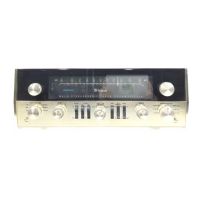MULTIPLEX DECODER
The multiplex decoder uses a special
Mclntosh developed detecting circuit. One of
the advantages of this circuit is the elimina-
tion of the critical adjustments necessary
with commonly used matrixing methods. This
circuit detects the L+R sidebands and auto-
matically matrixes the recovered informa-
tion with the L+R main carrier signal. This
circuit then yields the left and the right
program with maximum separation.
A temperature stabilized 19KC amplifier
locks-in a highly stable push-pull synchro-
nous oscillator. Apart from other advantages,
this method provides greatest noise immu-
nity. Balanced detectors cancel 19KC and
38KC components in the output and insure
low distortion.
A three-section sharp cut off filter rejects
SCA interference and reduces susceptibility
to spurious signals.
The MX110 has an MPX stereo indicator
that lights when the dial pointer crosses a
station broadcasting MPX stereo. A unique
circuit using a transistor operates the MPX
stereo indicator. The transistor is controlled
by a differential detecting circuit that am-
plifies the 19KC pilot signal. This circuit auto-
matically discriminates between the 19KC
signal and noise.
AUDIO
The MX110 audio amplifier consists of
three negative-feedback amplifying sections
in duplicate for the left and right stereo chan-
nels and a separate L+R monophonic ampli-
fier. The first section in each channel is a
feedback preamplifier used to amplify and
compensate for the input signals coming
from phonograph pickups or tape heads.
Level set controls are connected into the out-
put circuit of this preamplifier section when
the INPUT SELECTOR is switched to PHONO
1 or PHONO 2. These controls may be used
to maintain uniform loudness between phono
and tuner inputs. Skillful layout, grounding,
and shielding for low-hum pickup, metal film
resistors, low-noise tubes and extreme care
in manufacturing combine to reduce noise
and hum in the input amplifiers.
The second amplifier section in each chan-
nel is a cathode follower. The sharp cut-off
(18db per octave) rumble and high-frequency
filters are associated with this section. Input-
level set controls for the auxiliary inputs are
associated with this section. All the level set
controls are conveniently accessible
The third amplifier section is a two stage
negative feedback amplifier. The variable
bass and treble controls are included in the
feedback loop to maintain the lowest possible
distortion. For example a wave meter analy-
sis of the three amplifier sections of the
MX110 shows less than 1/10 of 1% dis-
tortion at 3 volts output. The MODE SELEC-
TOR, balance controls and left and right out-
puts are associated with the third amplifier
section.
The L+R monophonic amplifying section
is a feedback summing amplifier. It supplies
monophonic output as well as L+R output.
POWER SUPPLY
The power supply of the MX110 has re-
ceived very special design attention. Three
separate rectifier circuits are used.
First, a full-wave rectifier supplies D.C. to
the heaters of all audio stages.
A second bridge rectifier supplies D.C. to
the anodes of the audio stages.
Then a third full-wave rectifier supplies
D.C. to the tuner stages.
This elaborate power supply design in-
sures the lowest possible background hum
level and also the maximum stability. In
addition to this careful work the power trans-
former uses special magnetic shielding to
minimize possible hum pickup in the MX110
as well as in any other equipment used with it.
2

